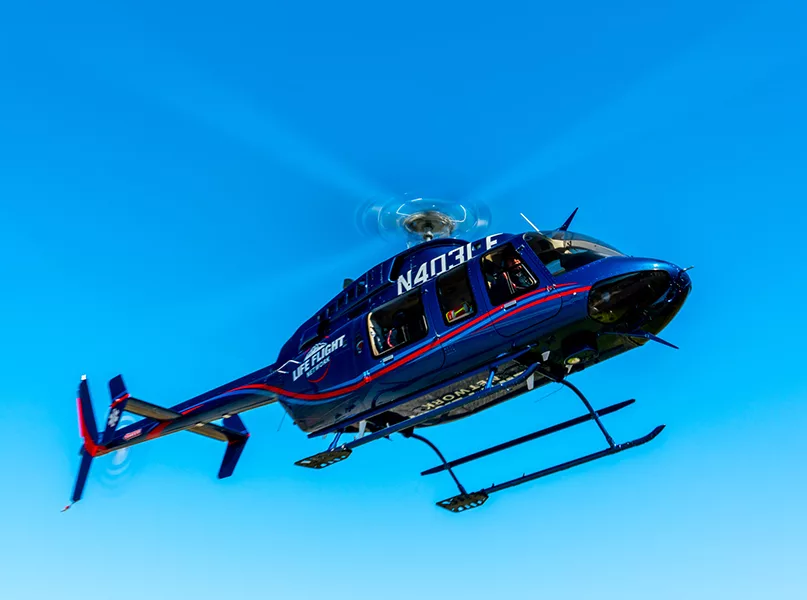Life Flight Network is tasked with providing efficient critical care transportation to ill or injured patients with safety and compassion. We examine its services with Chief Operating Officer (COO), Michael Weimer.
HELICOPTER HEROES
As a nationally recognized air medical transport service, covering a large part of the Pacific Northwest, Intermountain West and Alaska, Life Flight Network is on a mission to save lives.
As part of this mission, the organization seeks out rural communities, often far removed from specialty healthcare, where air medical services are a critical need. At its core, providing efficient and expedited aid in a medical emergency, while focused on safety and quality of care, is why Life Flight Network is one of the oldest and most respected air medical providers.
Working in emergency medical services was a vocational calling for Michael Weimer, Chief Operating Officer (COO) of Life Flight Network. “My career in healthcare started as a volunteer EMT in rural Idaho in 1993. I had a desire to help people in need which propelled me to pursue a career in paramedicine,” he opens.
After spending 27 years in the emergency services sector, Weimer began working as a flight paramedic with a hospital-based air medical program, a career field that he has remained in up to his present role where he is completing a Fellowship designation from the American College of Healthcare Executives.
The not-for-profit Life Flight Network began in 1978 as Emanuel Life Flight, owned by and operated by Emanuel Hospital. Emanual Life Flight was the first hospital-based air ambulance program on the West Coast and only the fourth in the nation.
It transported 121 patients in its first year with the inaugural aircraft, a French-made Allouette-3 helicopter. In 1993, Emanuel Life Flight merged with Aircare, a Providence Health System flight program.
“Our name was changed to reflect this milestone, and Emanuel Life Flight became Life Flight Network,” informs Weimer.
Along with the merger and name change, the decision came for the three largest healthcare providers in the Portland metropolitan area to jointly participate in the ownership and overall operation of Life Flight Network, while the day-to-day operations remained under the auspices of Legacy Emanuel Medical Center.
“In 2006, the consortium made a strategic decision to transfer the organization from governance of the hospital structure and separate it into its own entity,” says Weimer.
The consortium recognized Life Flight Network would need the strength of its own organizational structure if it was to survive in the rapidly growing and increasingly competitive air medical industry.


TOP TIER TRANSPORT
ICU-level care and life-saving transport is provided to seriously ill patients from the scene of an emergency or from one hospital to another by Life Flight Network, whose aircraft are equipped with the same state of the art medical equipment found in a hospital intensive care unit.
This set up allows the expert flight nurses, flight paramedics, and flight respiratory therapists to provide the highest levels of emergency care to patients in transport, saving precious time that is of the essence.
“Our teams stabilize, monitor, and care for even the most hemodynamically unstable patients throughout the duration of the flight,” outlines Weimer.
The number one objective is to save lives, but the ability to navigate the hospitals, which were at capacity, was tested during the COVID-19 pandemic.
“Healthcare has undeniably seen some significant changes over the last few years. The pandemic alone was enough to throw the entire world for a loop. That said, the healthcare industry is growing faster than any other in the US,” Weimer reveals.
With industry leading care and transport, Life Flight Network’s mission of saving lives during the pandemic was accomplished by employing the foremost emergency clinicians, pilots, and mechanics.
“By operating state of the art equipment, continually advancing operations, and acting with compassion and empathy, we perform beyond the expectations of our patients and healthcare partners to ensure they are receiving the level of care and service they deserve.”
Life Flight Network utilizes numerous aircraft to support operations and has its own FAA Part 135 Air Carrier Certificate. The range of each rotor wing is 300 nautical miles without refueling, and all rotor-wing aircraft use night vision goggles.
“We also operate the Pilatus PC-12, which is widely used in the air medical industry. The fixed-wing aircraft is very versatile, and capable of operating from short unimproved runways to large international airports,” explains Weimer.
The PC-12 cruises at 276 miles per hour and has a range of over 1,800 miles. There is also a fleet of specially equipped critical care ground ambulances, including the latest addition of six Class I Freightliner critical care ambulances.
As a not-for-profit, Life Flight Network reinvests earnings into the organization, ensuring healthcare partners and patients receive the quality of service and lifesaving care they depend upon. This reinvestment model provides advanced training for employees, allows new aircraft and ground ambulances to be acquired, and enables the latest cutting-edge medical equipment to be purchased.
It also offers community outreach and education to the company’s healthcare partners, all of which directly contribute to the well-being of patients. “We answer only to our patients. There are no shareholders or profit margins to consider, only lives to save. Our not-for-profit status is the foundation of our organization, giving us the freedom to focus on the patients and communities we serve,” Weimer says proudly.

“Seconds count in a critical medical emergency, and we refuse to see lives lost due to long wait times for lifesaving medical care”
– Michael Weimer, COO, Life Flight Network


REACHING RURAL COMMUNITIES
Life Flight Network has, and will continue to have, a strong track record of placing critical air medical resources in rural communities throughout the Pacific Northwest and Intermountain West. “Citizens should not have to choose between where they live and if they live,” says Weimer.
“We are currently in the process of opening two new bases. The first will be a 24-hour critical care transport base in Hoquiam, Washington, based at Bowerman Airport with both fixed-wing and rotor-wing aircraft.”
The new base is part of the continued effort to expand rural access to critical air medical resources, providing lifesaving care to Washington’s western peninsula and the surrounding communities.
Within the aircraft’s state of the art medical interior, the crew will operate a mobile intensive care unit, with the ability to perform a multitude of highly skilled medical functions during transport.
“The new base will infuse nearly $2 million in economic impact to the area, creating approximately 20 new jobs,” Weimer tells us.
The second base will be located at Good Shepherd Health Care System in Hermiston, Oregon, with a helicopter staffed 24 hours a day.
“The base highlights yet another step forward in our efforts to increase community access to quality critical care transport and speciality health care services, providing faster access to life-saving care for Hermiston and the surrounding communities,” he adds.

IN SAFE HANDS
Safety and risk management are core philosophies of Life Flight Network. To meet all the challenges associated with the safe transport of critically ill or injured patients by helicopter, fixed-wing aircraft, and ground ambulance, the focus on safety is unrelenting.
“All operations are vetted through the Safety and Risk Management department prior to implementation, and we continually evaluate our procedures to ensure the highest degree of safety is provided to our patients, healthcare partners, employees, and the public at large,” Weimer states.
An absolute premium is placed on the experience, training, and professionalism of the pilots and mechanics. Aircraft and ambulances utilized by Life Flight Network are maintained to the most rigorous standards in the industry, complemented by ongoing and comprehensive training to maintain the highest levels of proficiency.
“Our decision to update our fleet with a number of new Bell aircraft will increase overall standardization, improving efficiencies and associated logistics. Every decision we make is made with our patients and healthcare partners in mind,” assures Weimer.
With increased range and endurance, the new aircraft can respond to more calls with fewer delays for refueling. The standardization of the fleet, meanwhile, means aircraft maintenance will take less time, returning aircraft to service faster.
“Both translate to greater availability for our patients and a faster response when time is of the essence.”
Working in an emotive and urgent environment requires certain qualities and a special skill set. Employees must therefore be dedicated, as they are an integral part of the mission to save lives.
“We show up every day, motivated by our ability to have a positive impact on our communities, and nothing we do in the pursuit of that is too small. As the national leader in air medical care, we will continue to hold ourselves to the highest standards in the industry,” states Weimer.
Striving for excellence, quality, and innovation in everything, and continuing to prioritize expanded community access to medical services is of utmost importance to every member of the organization.
“Seconds count in a critical medical emergency, and we refuse to see lives lost due to long wait times for lifesaving medical care.”
It is imperative that patients and healthcare partners can trust and rely upon Life Flight Network in a time of crisis, and it is just as imperative to the company that it can provide lifesaving care with compassion and kindness.
“We are honored to have served the Pacific Northwest and Intermountain West for the last 45 years and we look forward to the future,” Weimer concludes.


























